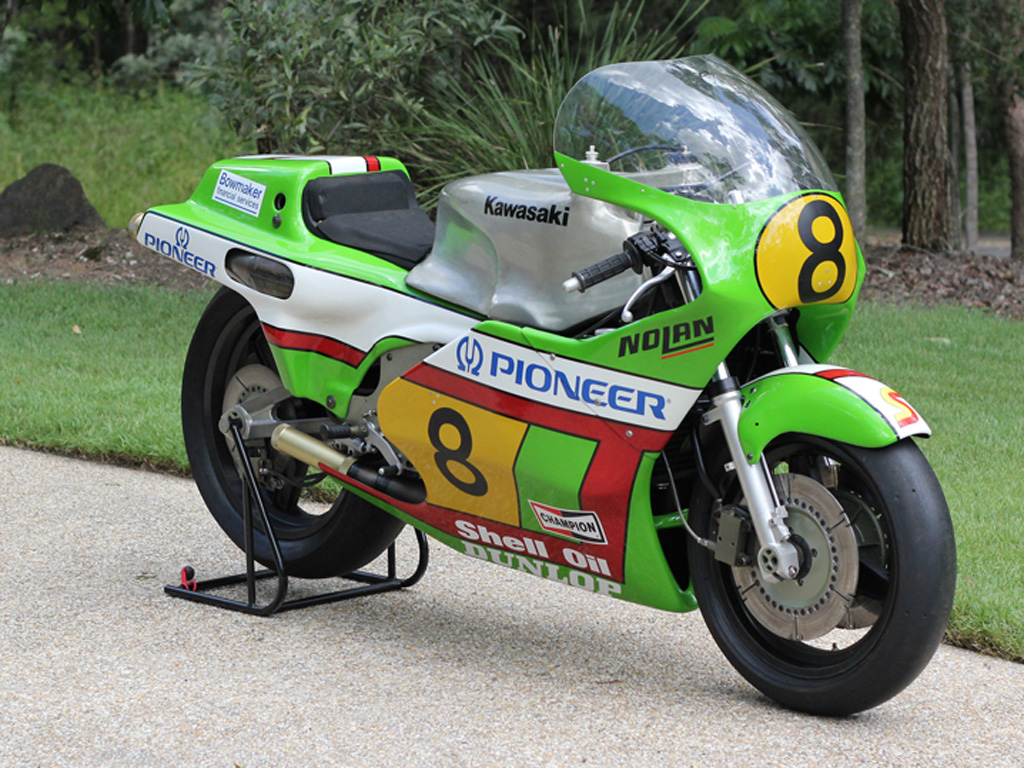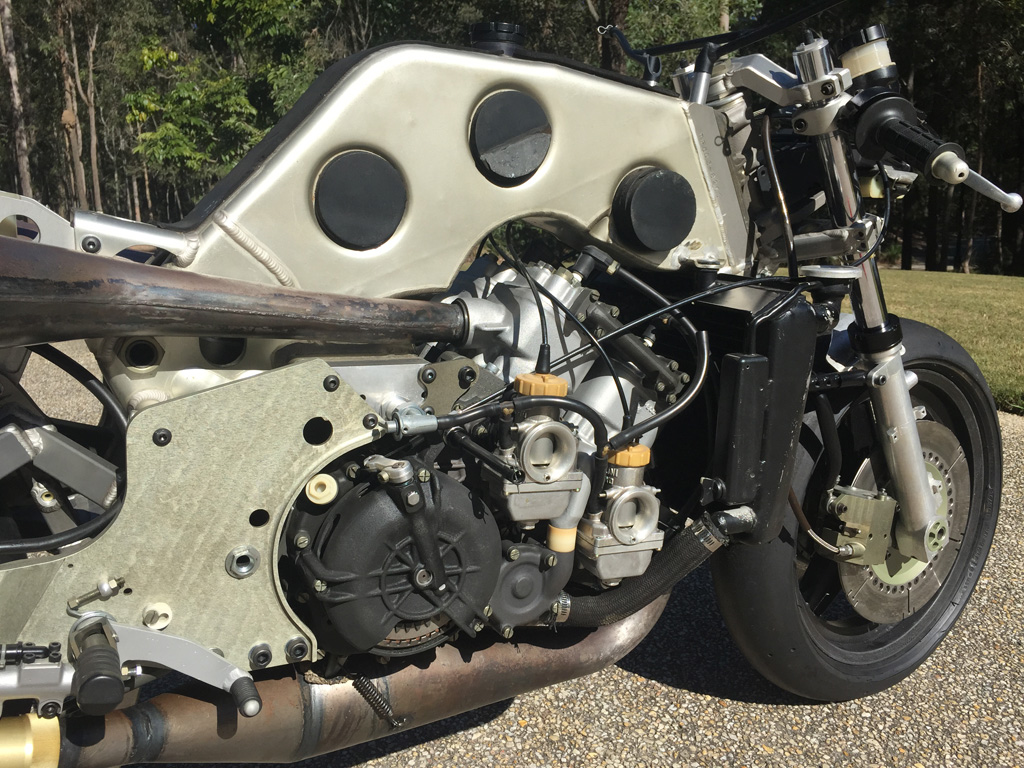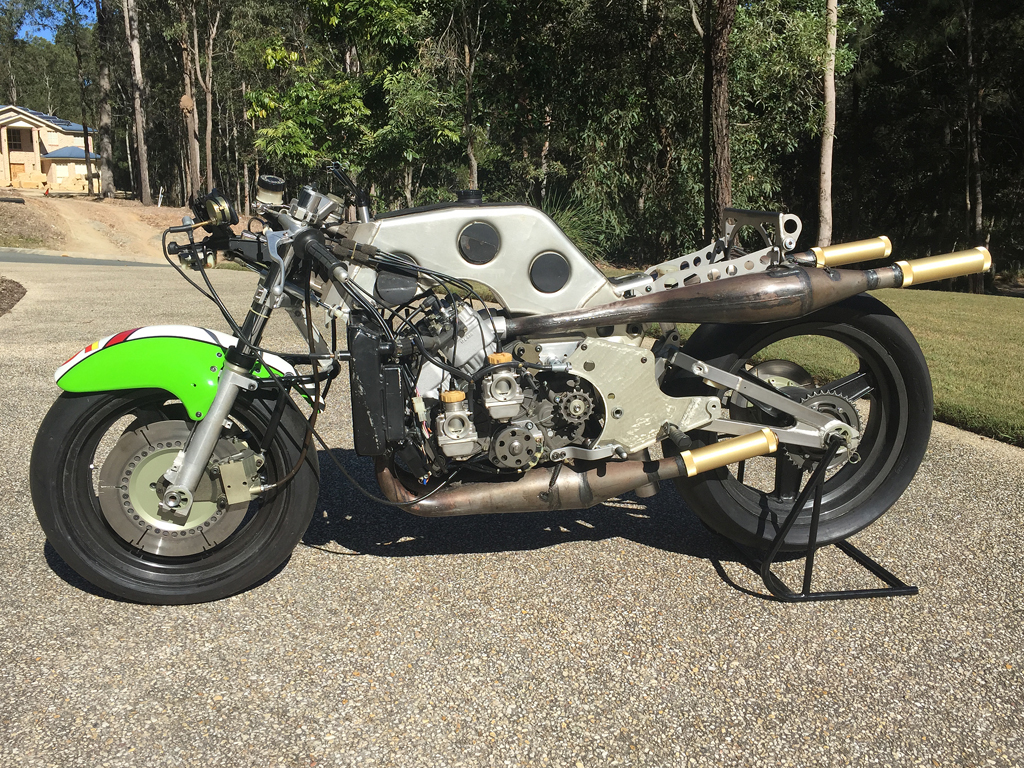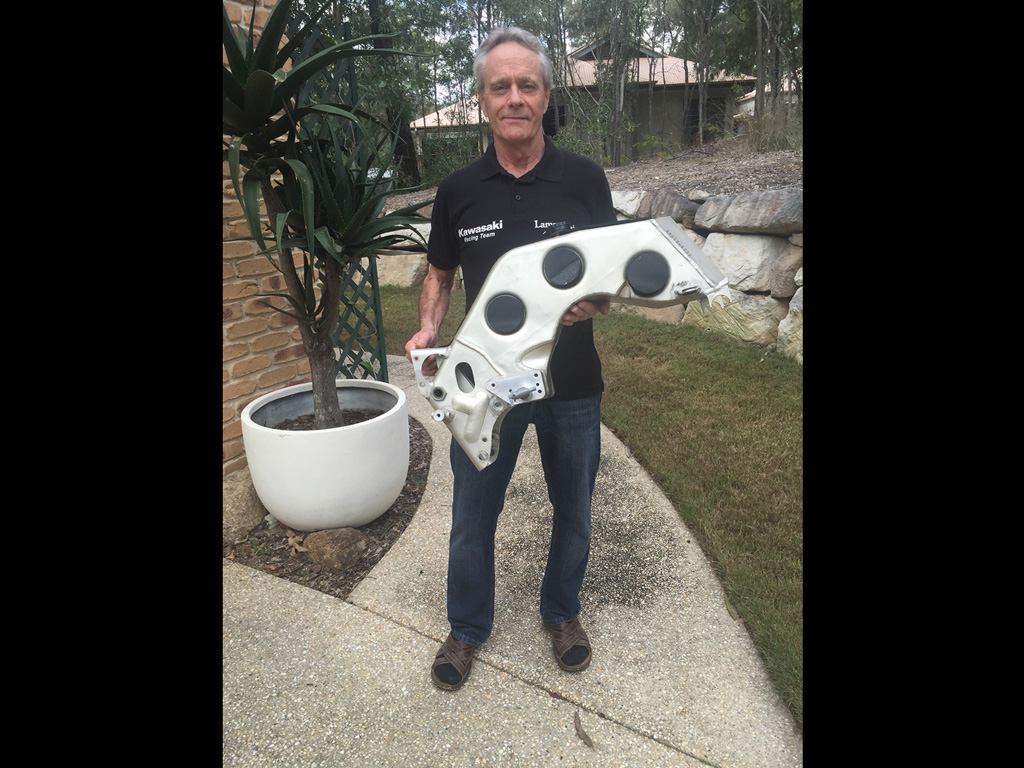In 1980, Kawasaki and its Japanese designer Kinuo Hiramatsu built a 500cc 4 cylinders Grand Prix machine to participate in the 500 cc world speed championship.
Some prototypes will emerge.
These revolutionary motorcycles used a single-cock aluminum frame cycle part, single-shock suspension and several revolutionary techniques.
The 500 cc engine is a four-cylinder square with water-cooled rotary distributors.


Two of these motorcycles will be used by the Australian world champion Kork Balklington and one will be sent to the USA
to participate in the American AMA championship with Eddie Lawson.
These motorcycles therefore ran to Kork Ballington in 1980, 81 and 82 Kork finishing 9th in the 1982 world championship.
Ballington will use these motorcycles in the British Championship events where he will obtain the title of champion of England with six victories and three track records.
40 years later, of these motorcycles, four will survive. One is currently in a British collection, another at the Kawasaki museum in Japan, one has remained in the USA and the last one has remained for 30 years at Kork Ballington and will be sold in recent years to a French collector.
These motorcycles therefore represent their history, track record and notoriety of the pilot (World Champion) an authentic and very rare collection machine.
More than forty years later, these rare motorcycles sleep in collections and are no longer used.

This is what Kork Ballington wrote to us two years ago when we acquired this motorcycle for a French collector:
“This is a rare example of a unique early 80s Grand Prix 4 cylinder 2 stroke. It is a ‘state of the art’ masterpiece of engineering (as the series of photos will show) that was produced in Kawasaki’s small race shop in the Akashi plant. To the best of my knowledge, a total of four were produced for the 1982 season. Two were allocated to Europe for Team Kawasaki UK, the only team to receive them for the World Championship events for my use. One went to Kawasaki USA for Eddie Lawson to use in the AMA Championship and one was used in Japan for R&D purposes. I acquired one of the two from Kawasaki UK and the other was returned to Japan where it and the bike used for R&D remain. One is in the possession of Kawasaki USA. This indicates that mine is the only example not in Kawasaki/Japanese ownership therefore the only original example likely to be offered to collectors. It bears the chassis number 8203. (3rd off the line in 1982).
In 1980 Kawasaki introduced the first of three models of KR500. The chassis of all three were a departure from the norm, being of monocoque construction. The design of each of the three models varied from one another, each an improvement on the previous design. By 1982 they had refined it and created the masterpiece of engineering which is the 1982 KR 500. Further development of the KR500 ceased at the end of 1982 when Kawasaki Japan pulled out of all forms of motorcycle racing due to the poor global economic situation.
It is without doubt unique. It is one of a kind, possibly the only 500cc GP bike produced with beautifully manufactured key chassis components that assemble to form an effective and efficient semi monocoque structure. The designer, Kinuo Hiramatsu was a perfectionist with advanced ideas. It has features possibly never used before by manufacturers, such as the quickly adjustable eccentric trail adjustment on the front fork at the spindle and the rapidly removable magnesium head angle plate to change the rake of the front forks. There are many more interesting features that can be seen in the sequence of photos. The attention to detail is impressive even, for the smallest of components. For example, the seat mounting screws have ‘o’ rings built into specially machined washers for the purpose of protecting the paint.
I spent a day at Kawasaki’s fabrication shop at the end of 1981 in Kyoto getting the tank moulded to my dimensions from a blank high density polystyrene block. The strange shape evolved in the quest to create a tank big enough, together with the capacity of the chassis, to hold enough fuel for the longest GP. Ours were never painted. It is coated with a clear coat which is original from date of manufacture.
The engineering is reminiscent of what one could expect in the aircraft industry and upper echelon automobile racing. Apart from typical steel components it has magnesium, titanium and aluminium parts. The fairing, seat and mudguard are of carbon fibre.
The motor is based on the successful KR250cc rotary valve tandem twin built in a square four cylinder configuration. The KR250 achieved high acclaim, winning a total of four world titles in as many years in the hands of myself in 1978 and 1979 and Toni Mang in 1980 and 1981 before development ceased.The greatest problem we had with the consecutive KR500s was lack of pre-season testing. Because of financial restrictions, Kawasaki could not indulge in meaningful testing before the beginning of the GP seasons and because each model was a total departure from the previous one, we would have to start from scratch setting it up each season. For example, the 1981 KR500 used Kayaba shock absorbers. By half way through the season we had the suspension set up functioning very nicely and gained two rostrum positions, 3rd at the Finnish GP and 3rd at the Dutch TT. I was racing for the lead in the ’81 British GP with fastest lap of the race when a rotary valve broke forcing me to retire. For 1982 Kawasaki surprisingly changed to Showa shock absorbers which, at the start of the season were not suitable without major modifications which we could not implement. Showa were contracted to Honda so we could not get technical back up to improve the units until the Showa technicians agreed to help us (discreetly) half way through the season. Modified units, delivered by cover of dark, made a big difference and my results improved immediately.
By the end of 1982 the KR500 was very competitive but too late to make an impact in the Grands Prix. I finished 9th in the 1982 World Championship placing nine times in the top ten.
We had significant results in British International events which were entered primarily for Kawasaki UK marketing and for development purposes.
I was the overall winner of the Shell Oil 500cc British Championship with six wins and a third and three lap records.
I was the overall winner of the Independent Television Superbike Challenge, a two race series at Donington Park with a 2nd and a 1st.
Other international events.
The Race of Aces at Snetterton 1st with lap record.
The World Cup at Donington Park. I achieved 4th and 2nd in each of 2 legs for 2nd overall with fastest lap of the meeting.
The results of this particular event held after the GP season had ended, were particularly pleasing as the entry was a ‘who’s who of GP racing’.My autobiography, Ballington Unkorked, has a detailed summation of the trials and tribulations that we, as a team encountered with the KR500s plus heaps of other interesting information.
I am offering this example for sale. It is in excellent and immaculate condition. It is in perfect running order and has not been raced or used other than being occasionally started up since the end of 1982. It was never crashed. It was last started in October
Kork Ballington, Winner of 4 Motorcycle World Titles and 31 Grands Prix - Kawasaki Factory Rider 1978 through 1982
2007 to make a video which was not intended for YouTube but which did end up there. (Google Kork Ballington KR500 ). After this I stripped the entire bike for an intensive clean up so I could store it without risk of degradation. During the strip I found slight damage to the bottom of the magnesium bottom gear case and parts of the waterways which was professionally repaired (as shown in photos of the stripped engine). I re-assembled the engine and left it dry i.e. without oil or water.
It has been in my climate controlled trophy room under cover since then. It has the original Dunlop slicks as last used. The rear slick, designated the RM by Dunlop is the largest cross ply slick ever produced for Grand Prix racing. This KR500 carries the #8 plate as I finished 8th in the 1981 World Championship. I have provenance for this motorcycle.”

Note, this is the original KR 500 from Kork Ballington.
This motorcycle is visible in the south of France.
Info and price on request.


